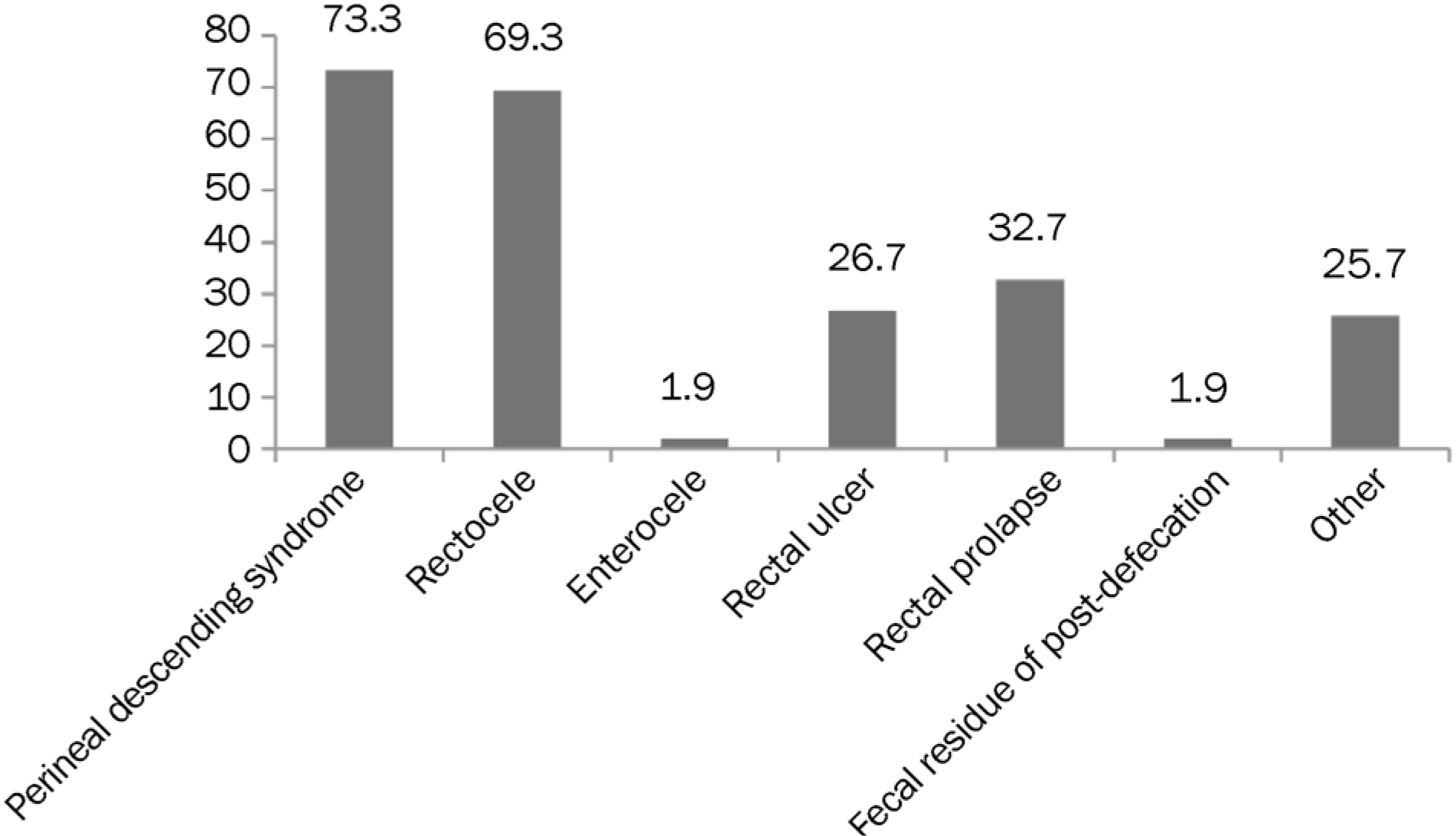Abstract
Background/Aims
Chronic constipation is a common gastrointestinal disorder diagnosed using Rome III criteria. Defecography is a radiographic method used to identify anatomic abnormalities of anorectum. The present study aimed to evaluate the defecographic findings in patients with severe idiopathic chronic constipation.
Methods
One hundred patients, who complained of severe idiopathic chronic constipation with abnormal balloon expulsion test, underwent defecography after injection of barium. An analysis of radiographs was performed by an expert radiologist for the diagnosis of descending perineum syndrome, rectocele, enterocele, rectal ulcer, rectal prolapse, fecal residue of post defecation, and etc. Then, they were compared between the two sexes.
Results
Normal defecography was only observed in two participants. Descending perineum syndrome was the most common abnormality (73.3%). The results showed that rectocele (80.8%) and descending perineum syndrome (69.2%) were most frequent in women. In males, descending perineum syndrome and rectal prolapse were more prevalent (87% and 43.5%, respectively). Compared with men, rectocele and rectal ulcer were more frequently observed in women (p<0.001, and p=0.04, respectively), while men were more affected by descending perineum syndrome (p=0.04). In total, women had a greater incidence of abnormal defecographic findings compared with men (p=0.02).
Go to : 
References
1. Rao SS, Rattanakovit K, Patcharatrakul T. Diagnosis and management of chronic constipation in adults. Nat Rev Gastroenterol Hepatol. 2016; 13:295–305.

2. Chu H, Hou X. Understanding of constipation symptoms and the diagnosis and management of constipation in Chinese physicians. PLoS One. 2016; 11:e0152801. eCollection 2016.

3. Iraji N, Keshteli AH, Sadeghpour S, Daneshpajouhnejad P, Fazel M, Adibi P. Constipation in Iran: SEPAHAN systematic review No. 5. Int J Prev Med. 2012; 3(Suppl 1):S34–S41.
4. American Gastroenterological Association. Bharucha AE, Dorn SD, Lembo A, Pressman A. American Gastroenterological Association medical position statement on constipation. Gastroenterology. 2013; 144:211–217.

5. Lomer M. Advanced nutrition and dietetics in gastroenterology. 1st ed.Chichester: John Wiley & Sons;2014.
6. De Lillo AR, Rose S. Functional bowel disorders in the geriatric patient: constipation, fecal impaction, and fecal incontinence. Am J Gastroenterol. 2000; 95:901–905.

7. Schiller LR. Nutrients and constipation: cause or cure? Pract Gastroenterol. 2008; 32:43.
9. Mahan LK, Escott-Stump S, Raymond JL. Krause's food and the nutrition care process. 13th ed.Philadelphia: Saunders;2011.
10. Wald A, Scarpignato C, Kamm MA, et al. The burden of constipation on quality of life: results of a multinational survey. Aliment Pharmacol Ther. 2007; 26:227–236.

11. Jamshed N, Lee ZE, Olden KW. Diagnostic approach to chronic constipation in adults. Am Fam Physician. 2011; 84:299–306.
12. Kim AY. How to interpret a functional or motility test-defecography. J Neurogastroenterol Motil. 2011; 17:416–420.
13. Diamant NE, Kamm MA, Wald A, Whitehead WE. AGA technical review on anorectal testing techniques. Gastroenterology. 1999; 116:735–760.

14. Rao SS, Ozturk R, Laine L. Clinical utility of diagnostic tests for constipation in adults: a systematic review. Am J Gastroenterol. 2005; 100:1605–1615.

15. Wald A. Etiology and evaluation of chronic constipation in adults. UpToDate, Basow, DS (Ed) UpToDate, Waltham, MA. 2008.
16. Drossman DA, Dumitrascu DL. Rome III: New standard for functional gastrointestinal disorders. J Gastrointest Liver Dis. 2006; 15:237–241.
17. Parks AG, Porter NH, Hardcastle J. The syndrome of the descending perineum. Proc R Soc Med. 1966; 59:477–482.

18. Bartolo DC, Read NW, Jarratt JA, Read MG, Donnelly TC, Johnson AG. Differences in anal sphincter function and clinical presentation in patients with pelvic floor descent. Gastroenterology. 1983; 85:68–75.

19. Kim SH, Hwang YH, Choi KP. A role of anorectal physiologic study for the diagnosis of chronic constipation. J Korean Soc Coloproctol. 2000; 16:231–238.
20. Reiner CS, Tutuian R, Solopova AE, Pohl D, Marincek B, Weishaupt D. MR defecography in patients with dyssynergic defecation: spectrum of imaging findings and diagnostic value. Br J Radiol. 2011; 84:136–144.

21. Nielsen MB, Buron B, Christiansen J, Hegedüs V. Defecographic findings in patients with anal incontinence and constipation and their relation to rectal emptying. Dis Colon Rectum. 1993; 36:806–809.

22. Mellgren A, Bremmer S, Johansson C, et al. Defecography. Results of investigations in 2,816 patients. Dis Colon Rectum. 1994; 37:1133–1141.
23. Shorvon PJ, McHugh S, Diamant NE, Somers S, Stevenson GW. Defecography in normal volunteers: results and implications. Gut. 1989; 30:1737–1749.

24. Andrade LC, Correia H, Semedo LC, Ilharco J, Caseiro-Alves F. Conventional videodefecography: pathologic findings according to gender and age. Eur J Radiol Open. 2014; 1:1–5.

25. Baek HN, Hwang YH, Jung YH. Clinical significance of perineal descent in pelvic outlet obstruction diagnosed by using defecography. J Korean Soc Coloproctol. 2010; 26:395–401.

26. Agachan F, Pfeifer J, Wexner SD. Defecography and proctography. Results of 744 patients. Dis Colon Rectum. 1996; 39:899–905.
27. Lefevre R, Davila GW. Functional disorders: rectocele. Clin Colon Rectal Surg. 2008; 21:129–137.

28. Arnold MW, Stewart WR, Aguilar PS. Rectocele repair. Four years' experience. Dis Colon Rectum. 1990; 33:684–687.
29. Pati o Paul RA, Lucas J, Wexner SD. Rectoceles: the incidence and clinical significance. Tech Coloproctol. 1996; 4:75–79.
30. Yoshioka K, Matsui Y, Yamada O, et al. Physiologic and anatomic assessment of patients with rectocele. Dis Colon Rectum. 1991; 34:704–708.

31. Gosselink MJ, van Dam JH, Huisman WM, Ginai AZ, Schouten WR. Treatment of enterocele by obliteration of the pelvic inlet. Dis Colon Rectum. 1999; 42:940–944.

32. Karlbom U, Nilsson S, Påhlman L, Graf W. Defecographic study of rectal evacuation in constipated patients and control subjects. Radiology. 1999; 210:103–108.

33. Walldén L. Defecation block in cases of deep rectogenital pouch. Nord Med. 1952; 48:1397.
34. Bozkurt MA, Kocataş A, Sürek A, Kankaya B, Kalaycı MU, Alış H. The importance of defecography in the assessment of the etiology of chronic constipation: an analysis of 630 patients. Ulus Cerrahi Derg. 2014; 30:183–185.

Go to : 
Table 1.
Demographic Characteristics of Patients
| Males (n=23) | Females (n=77) | |
|---|---|---|
| Age, year | 39.0±17.1 | 41.4±14.7 |
| Constipation duration, year | 5.6±5.5 | 5.8±4.4 |
Table 2.
Frequency of the ROME III Criteria in Participants
Table 3.
Frequency of the Abnormal Defecographic Findings in Patients according to Sex




 PDF
PDF ePub
ePub Citation
Citation Print
Print



 XML Download
XML Download